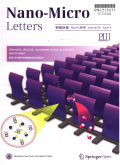- 钛学术文献服务平台 \
- 学术期刊 \
- 工业技术期刊 \
- 一般工业技术期刊 \
- 纳微快报(英文)期刊 \
A Bifunctional-Modulated Conformal Li/Mn-Rich Layered Cathode for Fast-Charging, High Volumetric Density and Durable Li-Ion Full Cells
A Bifunctional-Modulated Conformal Li/Mn-Rich Layered Cathode for Fast-Charging, High Volumetric Density and Durable Li-Ion Full Cells
基本信息来源于合作网站,原文需代理用户跳转至来源网站获取
摘要:
Lithium- and manganese-rich (LMR) layered cath-ode materials hold the great promise in designing the next-genera-tion high energy density lithium ion batteries. However, due to the severe surface phase transformation and structure collapse, stabiliz-ing LMR to suppress capacity fade has been a critical challenge. Here, a bifunctional strategy that integrates the advantages of sur-face modification and structural design is proposed to address the above issues. A model compound Li1.2Mn0.54Ni0.13Co0.13O2 (MNC) with semi-hollow microsphere structure is synthesized, of which the surface is modified by surface-treated layer and graphene/car-bon nanotube dual layers. The unique structure design enabled high tap density (2.1 g cm-3) and bidirectional ion diffusion pathways. The dual surface coatings covalent bonded with MNC via C-O-M linkage greatly improves charge transfer efficiency and mitigates electrode degradation. Owing to the synergistic effect, the obtained MNC cathode is highly conformal with durable structure integrity,exhibiting high volumetric energy density (2234 Wh L-1) and predominant capacitive behavior. The assembled full cell, with nanograph-ite as the anode, reveals an energy density of 526.5 Wh kg-1, good rate performance (70.3% retention at 20 C) and long cycle life (1000 cycles). The strategy presented in this work may shed light on designing other high-performance energy devices.

推荐文章
Li-ion电池的激光焊接
Li-ion电池
激光焊接
铝合金
不锈钢
富锂锰基正极材料zMnOx·(1-z)Li[Ni0.2Li0.2Mn0.6]O2的电化学性能
锂离子电池
正极材料
富锂
改性
掺杂
包覆
Li2ZrO3包覆锂离子电池正极材料Li[Li0.2Ni0.2Mn0.6]O2的制备及其电化学性能
锂离子电池
富锂锰基材料
Li2ZrO3
包覆改性
不同Ti4+含量掺杂Li[Li0.2Mn0.54Ni0.13Co0.13] O2的制备和电化学性能
xLi2MnO3·(1-x)LiMO2
Ti
掺杂改性
电化学性能
内容分析
关键词云
关键词热度
相关文献总数
(/次)
(/年)
引文网络
引文网络
二级参考文献 (0)
共引文献 (0)
参考文献 (61)
节点文献
引证文献 (0)
同被引文献 (0)
二级引证文献 (0)
2007(1)
- 参考文献(1)
- 二级参考文献(0)
2008(1)
- 参考文献(1)
- 二级参考文献(0)
2009(1)
- 参考文献(1)
- 二级参考文献(0)
2010(2)
- 参考文献(2)
- 二级参考文献(0)
2011(4)
- 参考文献(4)
- 二级参考文献(0)
2012(3)
- 参考文献(3)
- 二级参考文献(0)
2013(3)
- 参考文献(3)
- 二级参考文献(0)
2014(7)
- 参考文献(7)
- 二级参考文献(0)
2015(8)
- 参考文献(8)
- 二级参考文献(0)
2016(7)
- 参考文献(7)
- 二级参考文献(0)
2017(10)
- 参考文献(10)
- 二级参考文献(0)
2018(6)
- 参考文献(6)
- 二级参考文献(0)
2019(5)
- 参考文献(5)
- 二级参考文献(0)
2020(3)
- 参考文献(3)
- 二级参考文献(0)
2021(0)
- 参考文献(0)
- 二级参考文献(0)
- 引证文献(0)
- 二级引证文献(0)
引文网络交叉学科
相关学者/机构
期刊影响力
纳微快报(英文)
主办单位:
上海交通大学
出版周期:
月刊
ISSN:
2311-6706
CN:
31-2103/TB
开本:
出版地:
上海市东川路800号
邮发代号:
创刊时间:
语种:
eng
出版文献量(篇)
868
总下载数(次)
0
总被引数(次)
1499
期刊文献
相关文献
推荐文献
- 期刊分类
- 期刊(年)
- 期刊(期)
- 期刊推荐
一般工业技术
交通运输
军事科技
冶金工业
动力工程
化学工业
原子能技术
大学学报
建筑科学
无线电电子学与电信技术
机械与仪表工业
水利工程
环境科学与安全科学
电工技术
石油与天然气工业
矿业工程
自动化技术与计算机技术
航空航天
轻工业与手工业
金属学与金属工艺
纳微快报(英文)2022
纳微快报(英文)2021
纳微快报(英文)2020
纳微快报(英文)2019
纳微快报(英文)2018
纳微快报(英文)2017
纳微快报(英文)2016
纳微快报(英文)2015
纳微快报(英文)2014
纳微快报(英文)2013
纳微快报(英文)2012
纳微快报(英文)2011
纳微快报(英文)2010
纳微快报(英文)2009
纳微快报(英文)2021年第9期
纳微快报(英文)2021年第8期
纳微快报(英文)2021年第7期
纳微快报(英文)2021年第6期
纳微快报(英文)2021年第5期
纳微快报(英文)2021年第4期
纳微快报(英文)2021年第3期
纳微快报(英文)2021年第2期
纳微快报(英文)2021年第11期
纳微快报(英文)2021年第10期
纳微快报(英文)2021年第1期

 免费查重
免费查重










